2016 RENAULT GRAND SCENIC start stop button
[x] Cancel search: start stop buttonPage 19 of 270
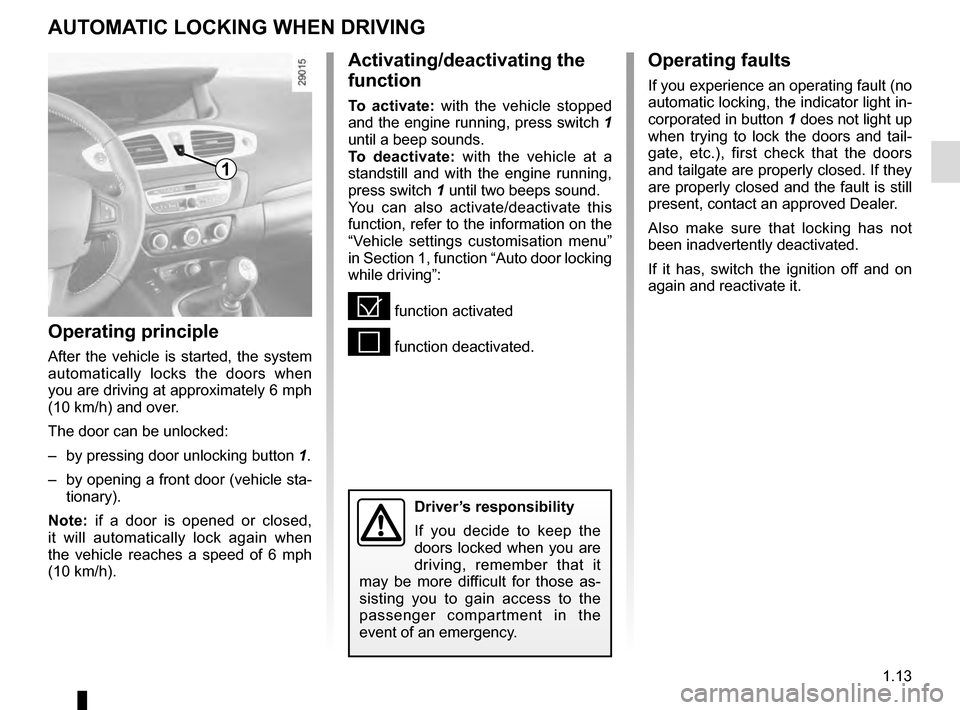
1.13
AUTOMATIC LOCKING WHEN DRIVING
Operating principle
After the vehicle is started, the system
automatically locks the doors when
you are driving at approximately 6 mph
(10 km/h) and over.
The door can be unlocked:
– by pressing door unlocking button 1.
– by opening a front door (vehicle sta- tionary).
Note: if a door is opened or closed,
it will automatically lock again when
the vehicle reaches a speed of 6 mph
(10 km/h).
Activating/deactivating the
function
To activate: with the vehicle stopped
and the engine running, press switch 1
until a beep sounds.
To deactivate: with the vehicle at a
standstill and with the engine running,
press switch 1 until two beeps sound.
You can also activate/deactivate this
function, refer to the information on the
“Vehicle settings customisation menu”
in Section 1, function “Auto door locking
while driving”:
= function activated
< function deactivated.
Operating faults
If you experience an operating fault (no
automatic locking, the indicator light in-
corporated in button 1 does not light up
when trying to lock the doors and tail-
gate, etc.), first check that the doors
and tailgate are properly closed. If they
are properly closed and the fault is still
present, contact an approved Dealer.
Also make sure that locking has not
been inadvertently deactivated.
If it has, switch the ignition off and on
again and reactivate it.
1
Driver’s responsibility
If you decide to keep the
doors locked when you are
driving, remember that it
may be more difficult for those as-
sisting you to gain access to the
passenger compartment in the
event of an emergency.
Page 57 of 270
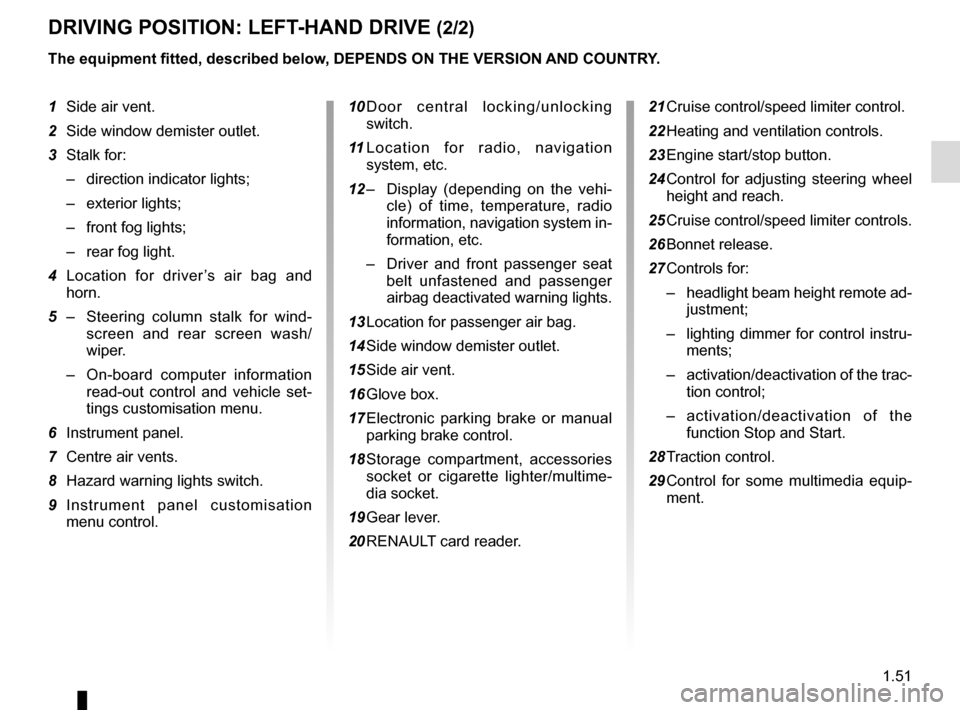
1.51
DRIVING POSITION: LEFT-HAND DRIVE (2/2)
1 Side air vent.
2 Side window demister outlet.
3 Stalk for:
– direction indicator lights;
– exterior lights;
– front fog lights;
– rear fog light.
4 Location for driver’s air bag and horn.
5 – Steering column stalk for wind-
screen and rear screen wash/
wiper.
– On-board computer information
read-out control and vehicle set-
tings customisation menu.
6 Instrument panel.
7 Centre air vents.
8 Hazard warning lights switch.
9 Instrument panel customisation menu control.
The equipment fitted, described below, DEPENDS ON THE VERSION AND COUNTRY.
21 Cruise control/speed limiter control.
22 Heating and ventilation controls.
23 Engine start/stop button.
24 Control for adjusting steering wheel height and reach.
25 Cruise control/speed limiter controls.
26 Bonnet release.
27 Controls for: – headlight beam height remote ad-
justment;
– lighting dimmer for control instru-
ments;
– activation/deactivation of the trac-
tion control;
– activation/deactivation of the
function Stop and Start.
28 Traction control.
29 Control for some multimedia equip- ment.
10 Door central locking/unlocking
switch.
11 Location for radio, navigation
system, etc.
12 – Display (depending on the vehi-
cle) of time, temperature, radio
information, navigation system in-
formation, etc.
– Driver and front passenger seat
belt unfastened and passenger
airbag deactivated warning lights.
13 Location for passenger air bag.
14 Side window demister outlet.
15 Side air vent.
16 Glove box.
17 Electronic parking brake or manual parking brake control.
18 Storage compartment, accessories socket or cigarette lighter/multime-
dia socket.
19 Gear lever.
20 RENAULT card reader.
Page 59 of 270
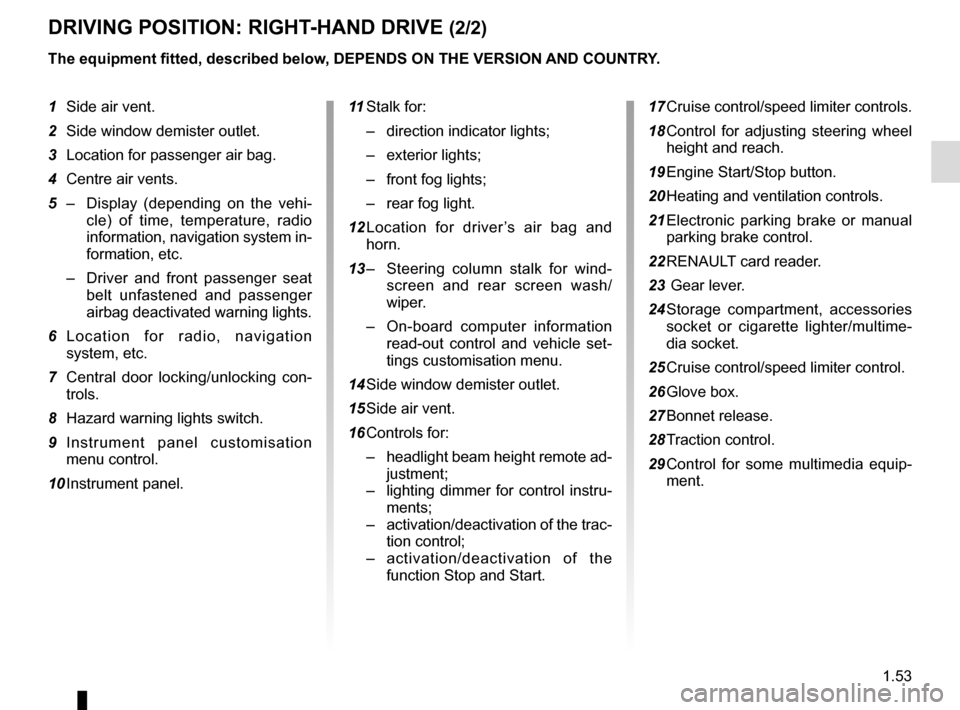
1.53
DRIVING POSITION: RIGHT-HAND DRIVE (2/2)
The equipment fitted, described below, DEPENDS ON THE VERSION AND COUNTRY.
1 Side air vent.
2 Side window demister outlet.
3 Location for passenger air bag.
4 Centre air vents.
5 – Display (depending on the vehi-
cle) of time, temperature, radio
information, navigation system in-
formation, etc.
– Driver and front passenger seat
belt unfastened and passenger
airbag deactivated warning lights.
6 Location for radio, navigation system, etc.
7 Central door locking/unlocking con- trols.
8 Hazard warning lights switch.
9 Instrument panel customisation menu control.
10 Instrument panel.
17 Cruise control/speed limiter controls.
18 Control for adjusting steering wheel height and reach.
19 Engine Start/Stop button.
20 Heating and ventilation controls.
21 Electronic parking brake or manual parking brake control.
22 RENAULT card reader.
23 Gear lever.
24 Storage compartment, accessories socket or cigarette lighter/multime-
dia socket.
25 Cruise control/speed limiter control.
26 Glove box.
27 Bonnet release.
28 Traction control.
29 Control for some multimedia equip- ment.
11
Stalk for:
– direction indicator lights;
– exterior lights;
– front fog lights;
– rear fog light.
12 Location for driver’s air bag and horn.
13 – Steering column stalk for wind-
screen and rear screen wash/
wiper.
– On-board computer information
read-out control and vehicle set-
tings customisation menu.
14 Side window demister outlet.
15 Side air vent.
16 Controls for: – headlight beam height remote ad-
justment;
– lighting dimmer for control instru-
ments;
– activation/deactivation of the trac-
tion control;
– activation/deactivation of the
function Stop and Start.
Page 66 of 270
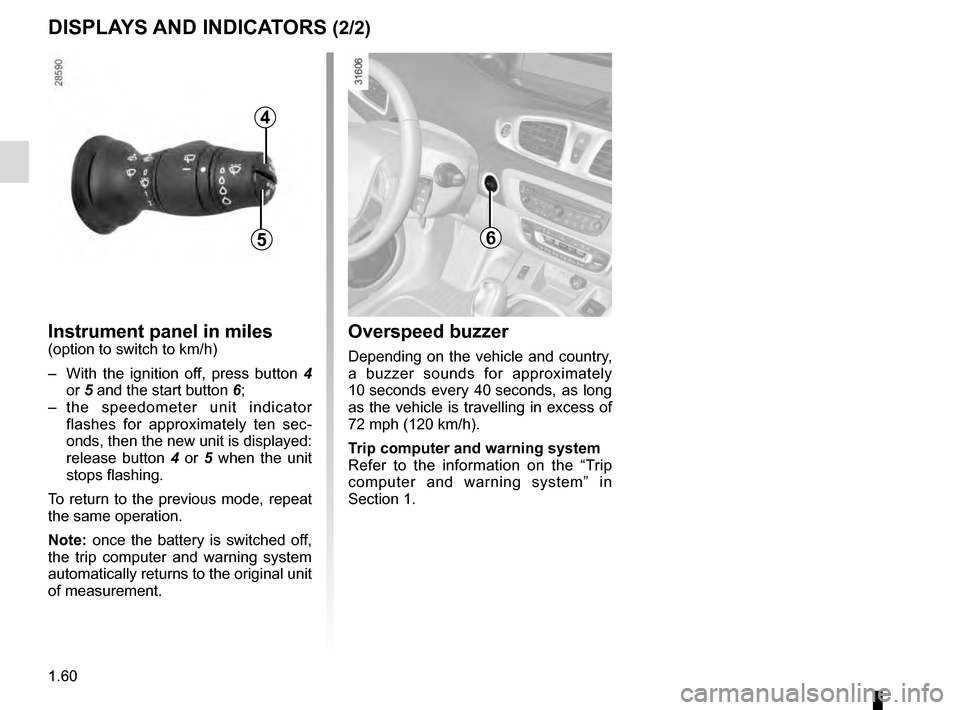
1.60
DISPLAYS AND INDICATORS (2/2)
Instrument panel in miles
(option to switch to km/h)
– With the ignition off, press button 4 or 5 and the start button 6;
– the speedometer unit indicator flashes for approximately ten sec-
onds, then the new unit is displayed:
release button 4 or 5 when the unit
stops flashing.
To return to the previous mode, repeat
the same operation.
Note: once the battery is switched off,
the trip computer and warning system
automatically returns to the original unit
of measurement.Overspeed buzzer
Depending on the vehicle and country,
a buzzer sounds for approximately
10 seconds every 40 seconds, as long
as the vehicle is travelling in excess of
72 mph (120 km/h).
Trip computer and warning system
Refer to the information on the “Trip
computer and warning system” in
Section 1.
4
56
Page 93 of 270

1.87
FUEL TANK (2/3)
Filling with fuel
With the ignition off, insert the nozzle to
open valve A and insert it fully before
turning it on to fill the fuel tank (risk of
splashing).
Keep the nozzle in this position through-
out the entire filling operation.
When the pump cuts out automatically
at the end of the filling procedure, a
maximum of two further filling attempts
may be made, as there must be suffi-
cient space in the fuel tank to allow for
expansion.
Make sure that no water enters the fuel
tank during filling. The valve A and its
surround must remain clean.
Petrol versions
Using leaded petrol will damage the
antipollution system and may lead to a
loss of warranty.
To ensure that the fuel tank is not filled
with leaded petrol, the fuel tank filler
neck contains a restrictor fitted with a
foolproof system which only allows
the nozzle for unleaded petrol to be
used (at the pump).
Persistent smell of
fuel
If you notice a persistent
smell of fuel you should:
– stop the vehicle as soon as traf- fic conditions allow and switch off
the ignition;
– switch on the hazard warning lights and ask your passengers
to leave the vehicle and to keep
away from traffic;
– contact an approved Dealer.
Vehicle fitted with the Stop and
Start function
To fill up with fuel, the engine must
be stopped (and not on standby):
stop the engine by pressing the
engine stop button 1 (please refer
to the information on “Starting and
Stopping the engine” in Section 2).
1
Page 97 of 270
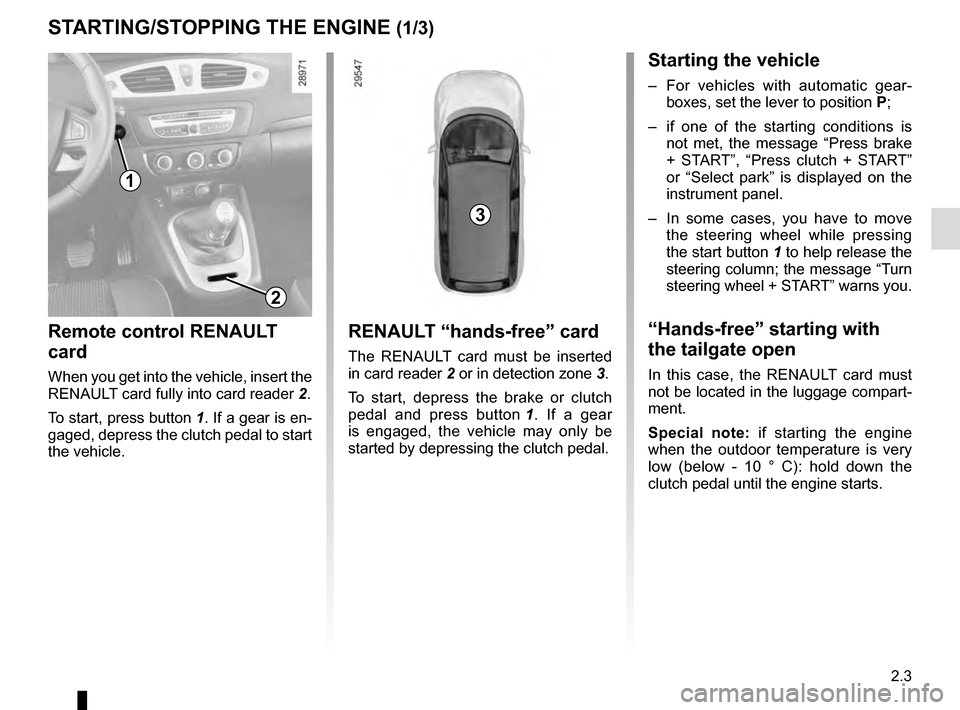
2.3
STARTING/STOPPING THE ENGINE (1/3)
Remote control RENAULT
card
When you get into the vehicle, insert the
RENAULT card fully into card reader 2.
To start, press button 1. If a gear is en-
gaged, depress the clutch pedal to start
the vehicle.
RENAULT “hands-free” card
The RENAULT card must be inserted
in card reader 2 or in detection zone 3.
To start, depress the brake or clutch
pedal and press button 1. If a gear
is engaged, the vehicle may only be
started by depressing the clutch pedal.
Starting the vehicle
– For vehicles with automatic gear- boxes, set the lever to position P;
– if one of the starting conditions is not met, the message “Press brake
+ START”, “Press clutch + START”
or “Select park” is displayed on the
instrument panel.
– In some cases, you have to move the steering wheel while pressing
the start button 1 to help release the
steering column; the message “Turn
steering wheel + START” warns you.
“Hands-free” starting with
the tailgate open
In this case, the RENAULT card must
not be located in the luggage compart-
ment.
Special note: if starting the engine
when the outdoor temperature is very
low (below - 10 ° C): hold down the
clutch pedal until the engine starts.
1
2
3
Page 98 of 270
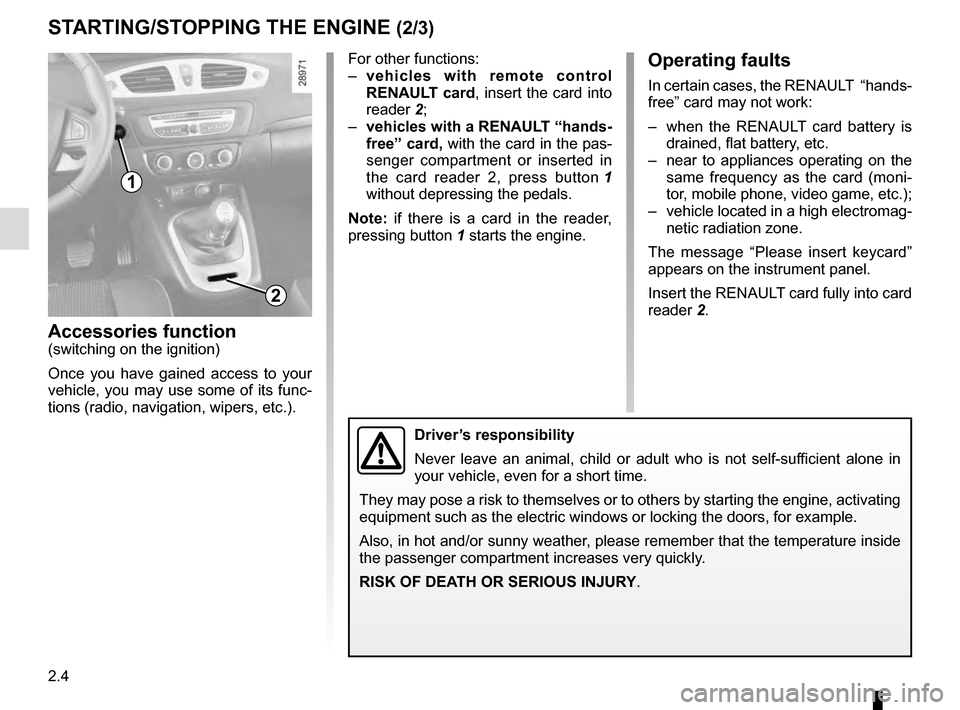
2.4
For other functions:
– vehicles with remote control
RENAULT card, insert the card into
reader 2;
– vehicles with a RENAULT “hands-
free” card, with the card in the pas-
senger compartment or inserted in
the card reader 2, press button 1
without depressing the pedals.
Note: if there is a card in the reader,
pressing button 1 starts the engine.
STARTING/STOPPING THE ENGINE (2/3)
Accessories function(switching on the ignition)
Once you have gained access to your
vehicle, you may use some of its func-
tions (radio, navigation, wipers, etc.).
Operating faults
In certain cases, the RENAULT “hands-
free” card may not work:
– when the RENAULT card battery is
drained, flat battery, etc.
– near to appliances operating on the same frequency as the card (moni-
tor, mobile phone, video game, etc.);
– vehicle located in a high electromag- netic radiation zone.
The message “Please insert keycard”
appears on the instrument panel.
Insert the RENAULT card fully into card
reader 2.
1
2
Driver’s responsibility
Never leave an animal, child or adult who is not self-sufficient alone in
your vehicle, even for a short time.
They may pose a risk to themselves or to others by starting the engine, \
activating
equipment such as the electric windows or locking the doors, for example\
.
Also, in hot and/or sunny weather, please remember that the temperature inside
the passenger compartment increases very quickly.
RISK OF DEATH OR SERIOUS INJURY.
Page 99 of 270
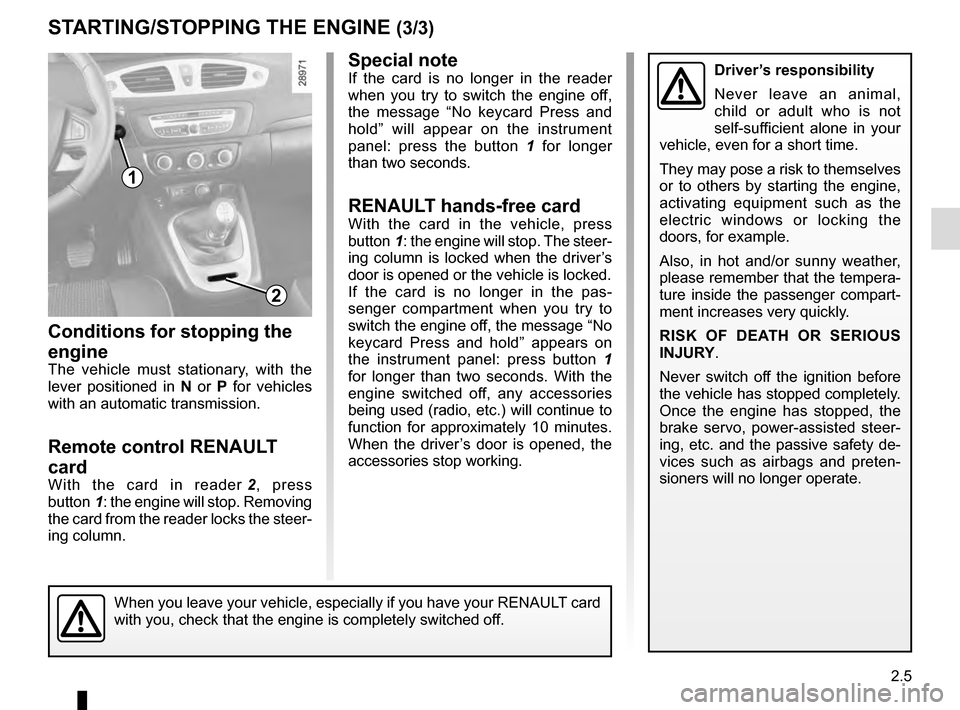
2.5
STARTING/STOPPING THE ENGINE (3/3)
Special note
If the card is no longer in the reader
when you try to switch the engine off,
the message “No keycard Press and
hold” will appear on the instrument
panel: press the button 1 for longer
than two seconds.
RENAULT hands-free cardWith the card in the vehicle, press
button 1: the engine will stop. The steer-
ing column is locked when the driver’s
door is opened or the vehicle is locked.
If the card is no longer in the pas-
senger compartment when you try to
switch the engine off, the message “No
keycard Press and hold” appears on
the instrument panel: press button 1
for longer than two seconds. With the
engine switched off, any accessories
being used (radio, etc.) will continue to
function for approximately 10 minutes.
When the driver’s door is opened, the
accessories stop working.
Conditions for stopping the
engine
The vehicle must stationary, with the
lever positioned in N or P for vehicles
with an automatic transmission.
Remote control RENAULT
card
With the card in reader 2, press
button 1: the engine will stop. Removing
the card from the reader locks the steer-
ing column.
When you leave your vehicle, especially if you have your RENAULT card
with you, check that the engine is completely switched off.
1
2
Driver’s responsibility
Never leave an animal,
child or adult who is not
self-sufficient alone in your
vehicle, even for a short time.
They may pose a risk to themselves
or to others by starting the engine,
activating equipment such as the
electric windows or locking the
doors, for example.
Also, in hot and/or sunny weather,
please remember that the tempera-
ture inside the passenger compart-
ment increases very quickly.
RISK OF DEATH OR SERIOUS
INJURY.
Never switch off the ignition before
the vehicle has stopped completely.
Once the engine has stopped, the
brake servo, power-assisted steer-
ing, etc. and the passive safety de-
vices such as airbags and preten-
sioners will no longer operate.